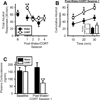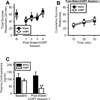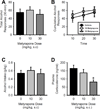Transient increase in alcohol self-administration following a period of chronic exposure to corticosterone
- PMID: 23643750
- PMCID: PMC3696398
- DOI: 10.1016/j.neuropharm.2013.04.036
Transient increase in alcohol self-administration following a period of chronic exposure to corticosterone
Abstract
Stressful life events and chronic stressors have been associated with escalations in alcohol drinking. Stress exposure leads to the secretion of glucocorticoids (cortisol in the human; corticosterone (CORT) in the rodent). To model a period of heightened elevations in CORT, the present work assessed the effects of chronic exposure to the stress hormone CORT on alcohol self-administration. Male Long Evans rats were trained to self-administer a sweetened alcohol solution (2% sucrose/15% alcohol) resulting in moderate levels of daily alcohol intake (0.5-0.7 g/kg). Following stable baseline operant self-administration, rats received CORT in the drinking water for 7 days. A transient increase in alcohol self-administration was observed on the first self-administration session following CORT exposure, and behavior returned to control levels by the second session. Control experiments determined that this increase in alcohol self-administration was specific to alcohol, unrelated to general motor activation, and functionally dissociated from decreased CORT levels at the time of testing. These results indicate that repeated exposure to heightened levels of stress hormone (e.g., as may be experienced during stressful episodes) has the potential to lead to exacerbated alcohol intake in low to moderate drinkers. Given that maladaptive drinking patterns, such as escalated alcohol drinking following stressful episodes, have the potential to put an individual at risk for future drinking disorders, utilization of this model will be important for examination of neuroadaptations that occur as a consequence of CORT exposure in order to better understand escalated drinking following stressful episodes in nondependent individuals.
Copyright © 2013 Elsevier Ltd. All rights reserved.
Figures





Similar articles
-
The effects of repeated corticosterone exposure on the interoceptive effects of alcohol in rats.Psychopharmacology (Berl). 2012 Apr;220(4):809-22. doi: 10.1007/s00213-011-2533-8. Epub 2011 Oct 21. Psychopharmacology (Berl). 2012. PMID: 22016195 Free PMC article.
-
Long-Evans rats acquire operant self-administration of 20% ethanol without sucrose fading.Neuropsychopharmacology. 2010 Jun;35(7):1453-63. doi: 10.1038/npp.2010.15. Epub 2010 Mar 3. Neuropsychopharmacology. 2010. PMID: 20200505 Free PMC article.
-
Metabotropic glutamate receptor 5 activity in the nucleus accumbens is required for the maintenance of ethanol self-administration in a rat genetic model of high alcohol intake.Biol Psychiatry. 2010 May 1;67(9):812-22. doi: 10.1016/j.biopsych.2009.09.016. Epub 2009 Nov 7. Biol Psychiatry. 2010. PMID: 19897175 Free PMC article.
-
Operant ethanol self-administration in ethanol dependent mice.Alcohol. 2014 May;48(3):295-9. doi: 10.1016/j.alcohol.2014.02.002. Epub 2014 Mar 13. Alcohol. 2014. PMID: 24721194 Free PMC article. Review.
-
To Infuse or Ingest in Human Laboratory Alcohol Research.Alcohol Clin Exp Res. 2020 Apr;44(4):764-776. doi: 10.1111/acer.14305. Epub 2020 Mar 15. Alcohol Clin Exp Res. 2020. PMID: 32056250 Free PMC article. Review.
Cited by
-
The role of varenicline on alcohol-primed self-administration and seeking behavior in rats.Psychopharmacology (Berl). 2015 Jul;232(14):2443-54. doi: 10.1007/s00213-015-3878-1. Epub 2015 Feb 7. Psychopharmacology (Berl). 2015. PMID: 25656746 Free PMC article.
-
Activation of mGluR2/3 following stress hormone exposure restores sensitivity to alcohol in rats.Alcohol. 2015 Sep;49(6):525-32. doi: 10.1016/j.alcohol.2015.03.008. Epub 2015 Jun 19. Alcohol. 2015. PMID: 26142564 Free PMC article.
-
Alcohol, stress hormones, and the prefrontal cortex: a proposed pathway to the dark side of addiction.Neuroscience. 2014 Sep 26;277:139-51. doi: 10.1016/j.neuroscience.2014.06.053. Epub 2014 Jul 3. Neuroscience. 2014. PMID: 24998895 Free PMC article. Review.
-
Acupuncture Alleviates Anxiety and 22-kHz Ultrasonic Vocalizations in Rats Subjected to Repeated Alcohol Administration by Modulating the Brain-Derived Neurotrophic Factor/Corticotropin-Releasing Hormone Signaling Pathway.Int J Mol Sci. 2021 Apr 14;22(8):4037. doi: 10.3390/ijms22084037. Int J Mol Sci. 2021. PMID: 33919862 Free PMC article.
-
α5GABAA subunit-containing receptors and sweetened alcohol cue-induced reinstatement and active sweetened alcohol self-administration in male rats.Psychopharmacology (Berl). 2019 Jun;236(6):1797-1806. doi: 10.1007/s00213-018-5163-6. Epub 2019 Jan 12. Psychopharmacology (Berl). 2019. PMID: 30637435 Free PMC article.
References
-
- Apter SJ, Eriksson CJ. The role of social isolation in the effects of alcohol on corticosterone and testosterone levels of alcohol-preferring and non-preferring rats. Alcohol Alcohol. 2006;41:33–38. - PubMed
-
- Armeli S, Carney MA, Tennen H, Affleck G, O’Neil TP. Stress and alcohol use: a daily process examination of the stressor-vulnerability model. J Pers Soc Psychol. 2000;78:979–994. - PubMed
Publication types
MeSH terms
Substances
Grants and funding
LinkOut - more resources
Full Text Sources
Other Literature Sources
Medical

